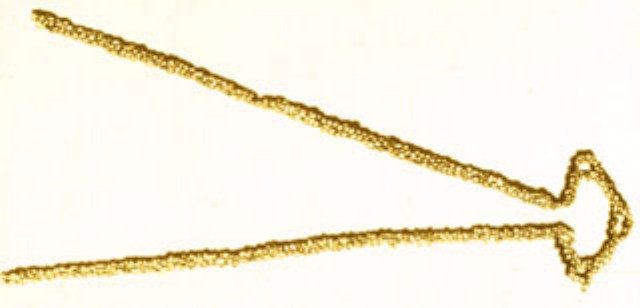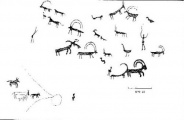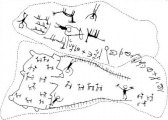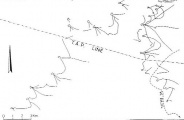Mysterious lines on the deserts of the Near East are massive ancient hunting tools, made up of low stone walls.
* A series of low, long walls are cleverly constructed traps that used the landscape.
* Gazelle, ibexes, wild asses and other large herding animals were the targets.
* No one is sure why the kites were abandoned.
British RAF pilots in the early 20th century were the first to spot the strange kite-like lines on the deserts of Israel, Jordan and Egypt from the air and wonder about their origins. The lines are low, stone walls, usually found as angled pairs, that begin far apart and converge at circular pits. In some places in Jordan the lines formed chains up to 40 miles long.
Were they made by some weird kind of fault? Ancient astronauts?
A new study of 16 of what are called desert kites in the eastern Sinai Desert confirms what many researchers have long suspected: The walls form large funnels to direct gazelle and other large game animals into killing pits. What's more, the kites are between 2,300 and 2,400-years-old, were abandoned about 2,200 years ago and are just the right size to have worked on local gazelles and other hooved game.
"The research shows that the construction of the kite was actually more sophisticated than it seemed before, their use was more diverse than we thought, and the ancients' knowledge of animal ethology was deeper and more intimate than one would think," said Uzi Avner of Ben-Gurion University-Eilat, in Israel.
"We have no doubt at all that the kites were built for hunting, not for any other suggested function."
Avner is a co-author of a paper on the new research which will appear in the July 2010 issue of the Journal of Arid Environments.
For a time, many researchers suspected the kites might be corrals for protecting domesticated animals, but that idea has fallen out of favor as more research has been done.
"The hunting theory is the most accepted, and it appears that for most kites this was indeed the use," said Dani Nadel, another kite researcher from the University of Haifa, Israel. "There are similar structures, either from wood or from stone, on most continents."
Interestingly, the walls of the kites are not high enough to actually block the animals. Rather, they just seem to channel herds in the right direction. Modern wildlife managers in the same region have used a similar approach by laying pipes on the ground to direct gazelles into a corral, Avner reports.
A careful examination of not just the kites but their locations in relation to pastures and migration routes makes it very clear that desert kites were specialized for specific types of animals. Before the 20th century the region was home to several different species of gazelle, wild asses, hartebeests, oryxes, ibexes, dorcas and onagers.
Some kites cleverly exploited low spots in the landscape to lure animals into the unseen killing pit.
"Indeed, the pit would have appeared to the animals in the funnel as an opening in the boundary walls of the kite through which they could flee," Avner reports.
Another sort of kite was found on steep slopes or ridges below a plateau or shoulder of a hill so that animals driven over the ridge would suddenly be confronted by the installation before and below them, Avner explained.
As for why the kites fell out of use, it's still a bit of a mystery, says Nadel.
"They were abandoned, in several south-Negev cases, by the beginning of the middle Bronze age," said Nadel. "This may suggest a climatic change and or a shift in subsistence strategies."
The article includes a slide show of desert kites showing how ancient hunters rounded up their prey.
http://news.discovery.com/archaeology/desert-lines-hunting-tool-kites.html |









 We would like to know more about this location. Please feel free to add a brief description and any relevant information in your own language.
We would like to know more about this location. Please feel free to add a brief description and any relevant information in your own language. Wir möchten mehr über diese Stätte erfahren. Bitte zögern Sie nicht, eine kurze Beschreibung und relevante Informationen in Deutsch hinzuzufügen.
Wir möchten mehr über diese Stätte erfahren. Bitte zögern Sie nicht, eine kurze Beschreibung und relevante Informationen in Deutsch hinzuzufügen. Nous aimerions en savoir encore un peu sur les lieux. S'il vous plaît n'hesitez pas à ajouter une courte description et tous les renseignements pertinents dans votre propre langue.
Nous aimerions en savoir encore un peu sur les lieux. S'il vous plaît n'hesitez pas à ajouter une courte description et tous les renseignements pertinents dans votre propre langue. Quisieramos informarnos un poco más de las lugares. No dude en añadir una breve descripción y otros datos relevantes en su propio idioma.
Quisieramos informarnos un poco más de las lugares. No dude en añadir una breve descripción y otros datos relevantes en su propio idioma.